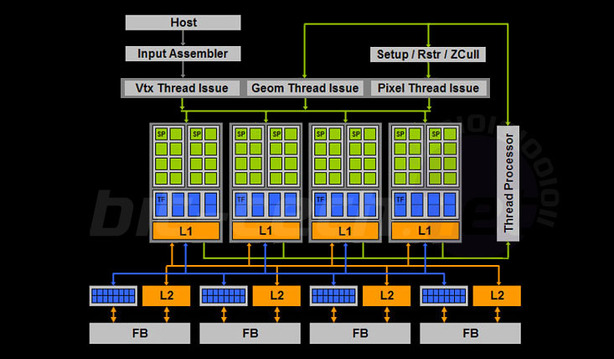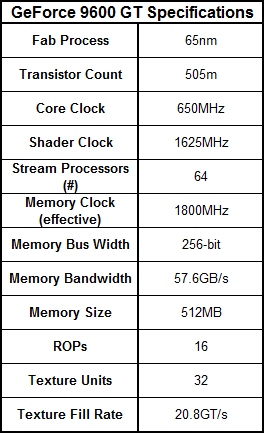GeForce 9600 GT in detail
Core Clock: 650MHzShader Clock: 1,625MHz
Memory Clock: 1,800MHz (effective)
The GPU that sits under the GeForce 9600 GT's heatsink is etched with G94-300-A1 and, like G92, it is manufactured on one of TSMC's 65nm processes. Based on my rather shaky measurements, G94's surface area is around 225mm² and it packs around 505 million transistors into that space – in other words, that's around two thirds of the G92 transistor count.
Despite being a part of the GeForce 9-series, it uses the same unified shader architecture as the GeForce 8-series – the G94 chip gets its performance from the 64 1D scalar stream processors which, at Nvidia's reference speed, run at 1,625MHz. They're arranged into four clusters of 16 shaders and share eight texture units that are able to both address and filter one texture per clock.
The texture units are clocked at 650MHz by default, although many partners are raising both the core and the shader clock speeds with their factory-overclocked offerings. Additionally, each of the shader clusters has its own independent cache, but Nvidia opts to keep its size confidential – it also doesn't detail what clock speed the cache is associated with either, but I think it's safe to say that it's running at the lower speed because of its association to the texture sampling hardware. The clusters are set out in the same way that Nvidia has used ever since it released its GeForce 8600-series powering G86 graphics chip.

Nvidia's G94 graphics chip in diagrammatic form…
Moving to the back end of the chip, there are 16 ROPs split into four partitions of four, just like there is in G92. Each of the partitions can process four pixels per clock and there's also support for 32 pixels per clock, per ROP partition, if all pixels are sampled with just the Z component. The ROPs use the updated design featured in G92, meaning there's support for the new compression technologies that help to improve the efficiency so that the chip is less reliant on bandwidth usage than G80's ROPs were.
Given that there's basically the same ROP hardware as G92—both in design and quantity—you'd be right to assume that the GPU has the same 256-bit wide memory interface. While this is a good thing, it's not something we haven't seen in the past from both Nvidia and ATI... but it's usually come with the refresh product. In that respect, you could almost class the GeForce 9600 GT as a refresh product, because it uses the same tried and tested architecture, with improvements added in areas where Nvidia deemed necessary (i.e. most of the chip, if we're comparing to GeForce 8600).

The PureVideo HD engine inside G94 is also the same as G92 and, with the release 174 Forceware driver, Nvidia is introducing some new post processing techniques to graphics cards based on these two GPUs (i.e. GeForce 8800 GS, GeForce 8800 GT, GeForce 8800 GTS 512 and GeForce 9600 GT). Nvidia says that the new features—Dynamic Contrast Enhancement and Dynamic Blue, Green and Skin Tone Enhancements—require a lot of horsepower and, given that there's a huge array of stream processors just sitting there, it makes sense to use them to handle the post processing load.
Additionally, there is also support for dual-stream decode in the new driver, which allows you to accelerate two video streams simultaneously on G92/G94-based products – great if you want to watch movies with director commentary playing in the foreground. One final thing that Nvidia has introduced with the release 174 driver is the ability to play HD movies back with Aero enabled under Windows Vista because, until now, Aero has been automatically disabled when playing back HD video. The good thing about this final feature is that, from what we've been told, it isn't limited to just G92 and G94-based products – Nvidia's representatives said that it'll be available on GeForce 8-series graphics cards that support PureVideo HD.
The new video features—for both G8x and G9x based products with PureVideo HD support—are things that we haven't had the time to test ourselves yet. That said, the demo we've seen that shows off the new post processing techniques looked reasonably good, but we're going to have to reserve our final judgement on it until we've tested it in our own lab. And since we've got an HD video article in the works, it makes sense to wait until then to test it out properly.
So, given that G94 uses the same technology as G92 – just with less of it, you're probably wondering why the GeForce 9600 GT isn't a part of a the GeForce 8-series? The good thing is that this was a question that was on our minds too and, after talking with Ujesh Desai, General Manager for GeForce graphics, at the CES Editor's Day, we were told that the reason was because the G92-based products should have been a part of the GeForce 9-series – the reason they weren't was simply down to timing.
He explained that if Nvidia had launched the GeForce 8800 GT and GeForce 8800 GTS 512 into the GeForce 9-series, it would have killed a large portion of its Q4 sales on products in the GeForce 8-series – not that this didn't happen anyway, since there is very little else worth considering... with a probable exception made for the GeForce 8800 GTX in certain scenarios.

MSI MPG Velox 100R Chassis Review
October 14 2021 | 15:04









Want to comment? Please log in.